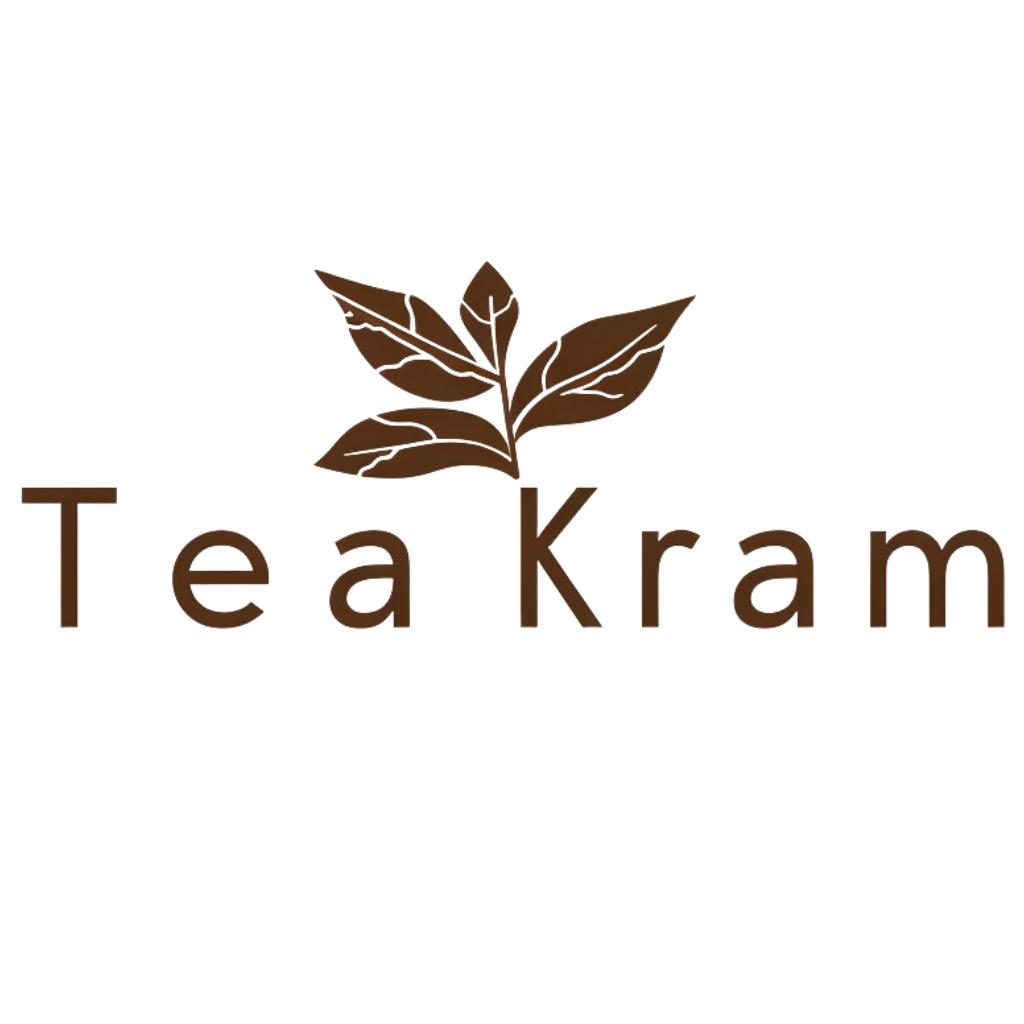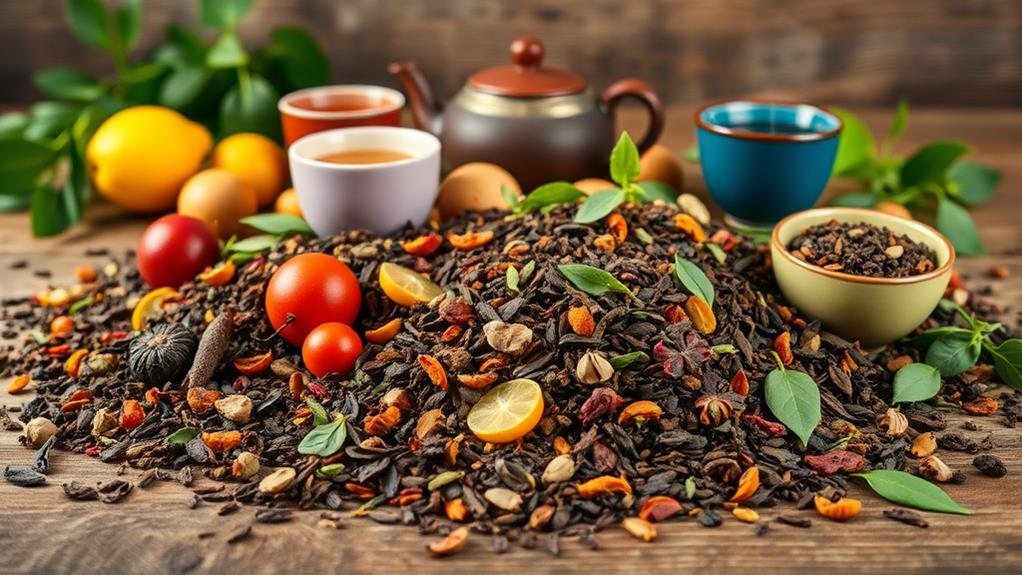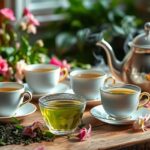Getting creative with blending your own teas is an exciting way to explore flavors! Start by choosing a base tea, like black or green, which should make up about 60% of your blend. Next, add herbal infusions, dried fruits, or spices to enhance the flavor. Remember to measure carefully using a scale and note your experiments in a notebook. Don't forget about steeping times and water temperature; these can make all the difference! Once you've perfected your blend, store it in airtight containers. There's so much more to discover about this enjoyable craft, and you'll want to keep experimenting!
Understanding Tea Types
When diving into the world of tea, it's crucial to understand the different types available. You've got a rich tapestry of tea varieties, each with its unique flavor profile and history.
Think about black tea, known for its boldness, which originates from regions like Assam and Darjeeling, and is also linked to heart health benefits. Then there's green tea, celebrated for its freshness and health benefits, with origins tracing back to China, and rich in antioxidants.
Oolong tea is a delightful middle ground, partly oxidized, offering a taste that dances between black and green. And let's not forget about white tea, the delicate gem that comes from young leaves and buds, often found in Fujian province.
Each variety showcases the tea plant's versatility, so understanding tea origins helps you appreciate each sip even more.
As you explore, consider how these different types can inspire your own blends. Combine flavors to create something fresh and unique!
Experimenting with various tea varieties opens up a world of creativity and innovation. So, let your imagination run wild as you discover the endless possibilities tea has to offer!
Essential Tools for Blending
To create your own tea blends, you'll need a few essential tools that make the process enjoyable and efficient. First, invest in a reliable scale. Precision is key when it comes to blending ratios, so measuring your ingredients accurately ensures your blends have the perfect balance. A good set of measuring spoons is also handy for smaller amounts, especially when experimenting with flavor intensity. Using tin storage can help maintain the freshness and flavor of your blends, ensuring that every sip is as delightful as the first.
Next, grab a mixing bowl where you can combine your tea leaves and other ingredients. This space lets you visualize your blend and play with different flavors without feeling cramped. A whisk or spoon helps to mix everything thoroughly, ensuring even distribution.
You'll also want some airtight containers for storage. Properly sealing your blends keeps them fresh and flavorful for longer. Labeling these containers can help you remember your favorite mixes and their specific blending ratios.
Lastly, don't forget a notebook! Jotting down your experiments allows you to track what works and what doesn't. Plus, it's a fun way to spark creativity and build your tea blending repertoire.
Flavor Profiles to Consider
Exploring various flavor profiles is essential for crafting unique tea blends that tantalize your taste buds. Start by considering the base of your blend. Black, green, or white tea can deliver different flavor foundations.
Think about adding herbal infusions like chamomile or peppermint to create a soothing experience. Each herbal tea brings its own character, which can enhance or contrast with your base.
Next, seasonal ingredients can invigorate your blends. In winter, spices like cinnamon or ginger can offer warmth, while summer might call for zesty citrus or refreshing mint. You can also experiment with dried fruits, such as hibiscus or apple, to add sweetness and depth.
Don't forget about the balance between flavors. A little tartness can brighten up your blend, while a touch of sweetness can mellow out stronger notes.
Basic Blending Techniques
Now that you've explored flavor profiles, it's time to get into some basic blending techniques!
Start by selecting your base ingredients, as they'll set the foundation for your unique tea. Consider experimenting with high-quality loose-leaf teas for a more complex flavor profile, as they allow better control over the steeping process and can lead to endless possibilities in your tea creations.
Then, think about how different flavors pair together and consider the best steeping methods to bring out those delicious notes.
Selecting Base Ingredients
When crafting your own tea blends, selecting the right base ingredients is crucial to achieving the desired flavor profile. Start by exploring various options: you might want to consider herbal options for a caffeine-free experience, or choose green bases for a fresh, grassy taste.
Black varieties offer a robust flavor, while oolong choices can bring complexity and depth. Don't forget about the delicate charm of white teas, which can add a subtle sweetness to your blend. Additionally, you can enhance your blends by considering the health benefits of different tea types, such as the antioxidant properties of green tea.
Next, think about flavored blends. These can range from fruity to floral and provide an exciting twist to traditional ingredients. You can mix and match to discover unique additions that surprise your palate.
For instance, try pairing a classic black tea with dried hibiscus for a refreshing zing, or blend a smooth oolong with warm spices for a cozy experience.
Flavor Pairing Essentials
Creating harmonious tea blends relies heavily on understanding flavor pairings. When you blend teas, think about how different flavors complement each other. This is especially true with herbal infusions, where the variety of tastes can create unique experiences. Seasonal flavors can also guide your choices, making your blends relevant and delightful throughout the year.
Here's a quick guide to help you explore some exciting flavor combinations:
| Flavor Base | Complementary Flavors | Seasonal Suggestions |
|---|---|---|
| Chamomile | Citrus, Honey | Spring |
| Green Tea | Mint, Ginger | Summer |
| Rooibos | Vanilla, Almond | Fall |
| Hibiscus | Berry, Cinnamon | Winter |
| Oolong | Peach, Jasmine | All Year |
Steeping Methods Explained
Understanding the right steeping methods can make or break your tea blending experience. When you mix different teas, you want to bring out the best flavors, and that starts with proper steeping.
First up, let's talk about water temperature. Different teas have unique needs; for example, delicate green teas prefer cooler water around 160°F, while bold black teas thrive in boiling water. Using the right temperature is crucial to avoid over-extracting bitter flavors or underwhelming your blend. Additionally, being mindful of water quality's impact on taste can elevate your brewing process, ensuring that you're starting with the best foundation for your blends.
Next, consider steeping times. Each tea demands its own timing to reach perfection. A black tea might need around 3 to 5 minutes, while a white tea often benefits from a gentler 4 to 6 minutes.
When blending, pay special attention to the steeping times of your chosen teas to create balance. If you mix a strong black tea with a light herbal, you might want to steep the herbal for a shorter time to avoid overpowering the blend.
Experiment with these variables, tweak them to your taste, and don't hesitate to take notes. The art of blending tea is all about discovery, so have fun and savor every sip!
Experimenting With Ingredients
When you start experimenting with ingredients, choosing the right base tea is key, as it sets the stage for your blend.
Don't forget to add flavorful components like herbs or spices to create exciting twists, and remember to balance the aromatic profiles so that every sip is harmonious.
With a bit of creativity and taste-testing, you'll discover unique combinations that are all your own!
Choosing Base Teas
Choosing the right base tea is essential for crafting a blend that truly resonates with your palate. Start by exploring different types like green tea, black tea, oolong varieties, and white tea. Each tea has unique qualities, influenced by its tea origins and processing methods.
Green tea offers a fresh, grassy flavor, while black tea provides a bold, robust taste. Oolong varieties can range from floral to fruity, adding depth to your blend.
If you're looking for something caffeine-free, consider herbal infusions. They're perfect for relaxing evenings!
When you choose your base, think about the blending ratios, as these will affect the final flavor profile. For example, mixing a strong black tea with a lighter green tea can create a balanced brew.
Don't forget about flavored blends! You might want to experiment with different base teas to see how they pair with fruits, spices, or floral notes.
As you explore these options, consider how caffeine levels will affect your enjoyment throughout the day. So, dive in and unleash your creativity—finding the right base tea is just the beginning!
Adding Flavor Components
Once you've selected your base tea, it's time to enhance your blend by adding flavor components that reflect your personal taste. Think of this as your chance to get creative!
You can start with herbal additions like chamomile or mint for a refreshing twist. If you're feeling zesty, why not incorporate some citrus twists, like lemon or orange peels? They'll brighten up your brew in no time!
Spice infusions can also add a whole new layer of flavor. A pinch of cinnamon or cardamom can provide warmth, while floral notes from dried rose petals or lavender can lend a delicate touch.
If you've got a sweet tooth, consider sweet enhancements like honey granules or dried fruits for extra flavor.
Don't forget about nutty flavors! Toasted almonds or hazelnuts can create a rich experience. For something more adventurous, smoky undertones from lapsang souchong will surprise your palate.
Seasonal ingredients, like pumpkin spice in fall or fresh berries in summer, can keep your blends exciting all year round.
Balancing Aromatic Profiles
How do you achieve a harmonious blend of aromas in your tea? It all starts with understanding aromatic balance. You want each ingredient to contribute to a delightful sensory experience, creating flavor harmony that excites your palate. Experiment with different ingredients to discover ingredient synergy—some work beautifully together while others clash.
Begin by focusing on profile development. Consider the aroma intensity of each component: floral notes may need to be tempered by earthier herbs to prevent overpowering your blend. Play with blending ratios; a little goes a long way! For instance, if you love mint, don't drown your tea in it—just a sprinkle can elevate the taste.
Taste layering is another fun technique. Start with a base flavor and add complementary notes gradually, allowing your taste buds to guide you.
Balancing Flavors and Aromas
Achieving the perfect balance of flavors and aromas in your tea blends can transform an ordinary cup into a remarkable experience. When you start mixing your favorite teas, think about how different flavors interact. You want to create aromatic harmony, where each ingredient complements the others instead of clashing.
For instance, if you're blending a strong black tea with a delicate green tea, consider how their flavors will mesh.
To maintain flavor balance, start with a base tea that you love, then slowly add in other flavors. A good rule of thumb is to keep your base at about 60% of the blend and let the other components make up the rest. This way, the base tea shines through while the added flavors enhance it.
Don't be afraid to experiment! A pinch of dried herbs or a splash of fruit can elevate your blend.
Just remember to taste as you go—this is where the magic happens. If a blend feels off, adjust it until it feels right.
With trial and error, you'll discover unique combinations that excite your palate and offer a delightful twist to your tea experience. Happy blending!
Storing Your Custom Blends
After you've crafted your perfect tea blend, storing it properly is key to preserving its flavors and aromas. To keep your innovative creations fresh, invest in high-quality airtight containers. These will protect your blends from humidity control issues and prevent flavor fading over time.
Remember, tea loves a stable environment, so aim for temperature stability; a cool, dark cabinet works wonders!
Light exposure can be a stealthy enemy for your tea's fragrance retention, so avoid clear jars or placing them near windows. Labeling blends is a smart move, too—especially if you're blending batches. It not only helps you track your favorites but also keeps your tea storage organized and fun.
For long-term preservation, consider vacuum sealing your blends. This method minimizes air exposure and keeps your flavors vibrant for months. If you're experimenting with diverse ingredients, separate containers might be necessary to ensure that strong scents don't mingle unexpectedly.
In short, treat your custom blends with care, and they'll reward you with delightful sips for many brews to come! Happy blending, and may your tea adventures be ever delicious!
Sharing and Enjoying Your Creations
Sharing your custom tea blends can be one of the most rewarding experiences of your tea journey.
It's not just about the flavors; it's about the connections you make.
Here are four exciting ways to share and enjoy your creations:
- Host a Tea Tasting: Invite friends over and let them explore your unique blends. Encourage them to share their thoughts and experiences.
- Engage in Recipe Exchange: Create a platform for sharing your recipes, allowing others to contribute their own innovative blends. This fosters a sense of community and creative inspiration.
- Seasonal Themes: Align your blends with the seasons, hosting gatherings that celebrate flavors of autumn or refreshing summer teas. This adds an element of fun and flavor exploration.
- Tea Journaling: Document your blend sharing experiences and personal insights. This not only enhances your journey but also serves as a treasure trove of ideas for future blends.
FAQ
How Do I Choose a Base Tea for My Blend?
To choose a base tea, consider various base tea types like black, green, or white. Explore their distinct flavor profiles, and think about how they'll complement your other ingredients for a balanced, innovative blend.
Can I Blend Herbal Teas With Traditional Teas?
Yes, you can blend herbal teas with traditional teas. By exploring herbal profiles and flavor balancing, you create innovative combinations that excite your palate. Experiment with different ratios to discover unique, harmonious flavors that delight your senses.
What Are Common Mistakes in Tea Blending?
When blending tea, you might use wrong ratios, creating overpowering flavors. Don't forget inadequate storage can ruin your mix, and poor quality ingredients will lead to disappointing results. Experiment wisely to enhance your tea experience!
How Long Should I Steep My Custom Blends?
When it comes to steeping your custom blends, think of it as a delightful dance. Experiment with steeping times—typically 3 to 5 minutes—to unlock vibrant flavor profiles and discover your signature brew. Enjoy the journey!
Are There Health Benefits to Specific Tea Combinations?
Yes, specific tea combinations can enhance health properties and create unique flavor profiles. For instance, blending green tea with ginger boosts antioxidants while adding a spicy kick. Explore various pairings to discover innovative health benefits and delightful tastes.
Final Thoughts
Now that you've got the scoop on blending your own teas, it's time to unleash your inner tea alchemist! Remember to keep experimenting with different flavors and aromas, just like a mad scientist in a lab. Your unique blends can spark joy, relaxation, or even a lively chat with friends. So grab your tools, mix it up, and enjoy sipping on your custom creations. Who knows, you might just brew the next big thing in tea!



